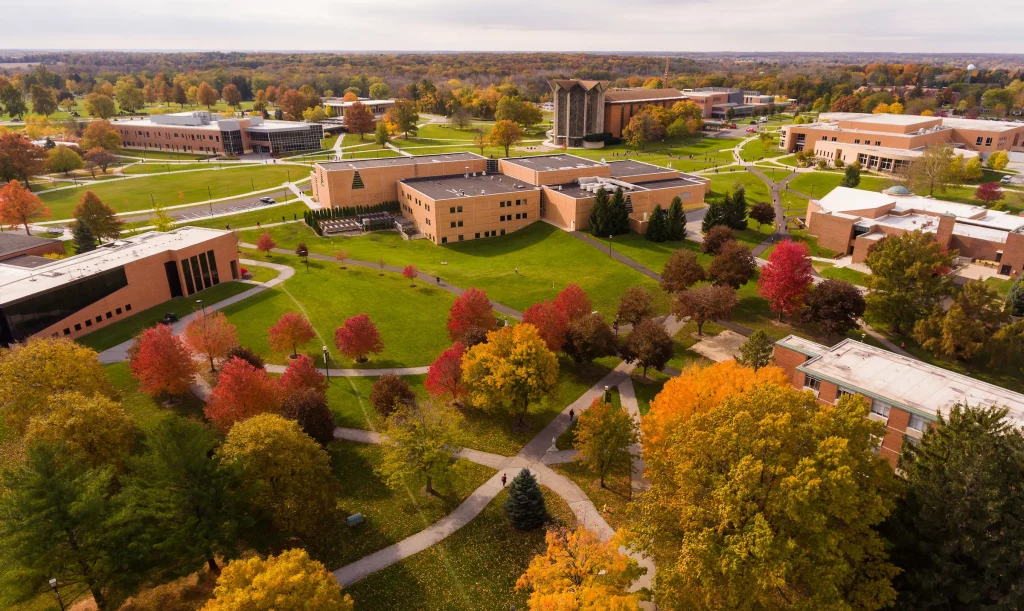Students Learn About International Humanitarian Law With New Red Cross Club
The earth shakes as another bomb hits the city. The explosion sends shards of glass and brick flying into the streets. Civilians run for cover. In the midst of the chaos, Red Cross aid workers quickly evacuate the wounded from the pandemonium. This may sound like war, but in fact, it is only a simulation.
When Amy Atchison, assistant professor of political science and international relations, began teaching International Humanitarian Law she knew the best way to engage students would be through hands-on activities.
“International Humanitarian Law is the rule of war,” Professor Atchison explained, “and like any field of law, students can feel very disconnected from the subject if they aren’t really engaged. But this law is incredibly important for our students because many of them want to work in humanitarian fields. These laws spell out not just the conduct of war, but also the treatment of civilians in a conflict zone.”
To engage the students, Professor Atchison staged a series of wartime exercises based on the ‘Raid Cross’ activities developed by the Red Cross.
“Basically, we waged an in-class war,” Professor Atchison said. “These exercises not only highlighted some of the most important principles of International Humanitarian Law, they also gave the students at least a small sense of the victims’ need for justice and the difficulty the international system has providing it.”
In an effort to bring greater awareness of International Humanitarian Law to Valparaiso University, Professor Atchison recruited students to form a Red Cross Club on campus. Valpo, in collaboration with the Porter County Chapter of the American Red Cross, is part of a pilot program with nine chapters across the United States. The Red Cross Club works to educate individuals on what is legally acceptable behavior in the heat of battle.
Ather Ahmed ’14, an International Service major and team leader for Valpo’s Red Cross Club, noticed that many of the legal mistakes he made during training were similar to those made by his team members. These mistakes, which in real life would often be categorized as war crimes, include things like indiscriminately bombarding civilian populations in an artillery battle or preventing humanitarian aid from reaching those in need. International Humanitarian Law attempts to curb these mistakes through educating people on the key principles of the law.
For example, “on a battlefield, it’s illegal to treat your own wounded while leaving the enemy to die. International Humanitarian Law obliges participants to triage all of the wounded on the battlefield and treat the most severe injuries first, regardless of which uniform they’re wearing,” Ather said.
The seven principles that guide the critical decisions the Red Cross makes on a regular basis are humanity, impartiality, neutrality, independence, voluntary service, unity, and universality. Each principle ensures that regardless of the circumstance, proper aid and responsiveness is provided to each victim.
“Knowing that military personnel have to make razor-sharp decisions in intense moments that also must be legal gave me a deeper appreciation for the work they do,” Ather said.
Many students came to realize just how difficult it can be to remember the moral decisions one should make while immersed in these intense situations.
“I first did the Raid Cross simulations in Professor Atchison’s class, and the students who were in the class all committed all war crimes in the heat of our simulated battles,” said Ashley Watson ’14, the student-leader of the club. “It was not a matter of if they would commit war crimes, but when. We already knew what not to do, and yet when we were in the simulation, we still committed the crimes.”
Professor Atchison noted, “The crimes they committed weren’t committed intentionally; because of that, it really hit home to them that a lot of atrocities are committed during the so-called ‘fog of war’.”
While students may never plan to fight in a battle or rescue an injured war victim from danger, the Red Cross Club offers an opportunity to harness what is learned in the classroom and apply it to real-life situations. To assess the success of the program, International Humanitarian Law Peer Education Program Officers Emily Kenney and Kimberly Heyne, who work for the American Red Cross National Headquarters in Washington, D.C., visited campus and met with several of the students involved. They quickly observed a close connection between the goals of the Raid Cross simulations and the mission of Valparaiso University.
“The International Humanitarian Law Peer Education Program is a perfect fit for Valpo because of the University’s focus on internationalization and the service-oriented student body,” Kenney said. “Service-learning is a passion for these students. It isn’t just for class credit – it’s part of the culture at Valparaiso University.”
Kenney said the students demonstrated a clear understanding of International Humanitarian Law, and she’s excited to see the students take ownership of these principles and educate their peers.
“I think the goal for the 22nd century is to abolish war, and the way to do that is through treaties like the Geneva Convention,” Ather said. “We need to slowly mitigate war and the brutality of war, and I think it takes the entire public to be aware that these rules exist for this goal to be reached.”
The Red Cross Club strives for growth on campus and seeks additional members who share a passion for humanitarian justice and possess a desire to develop their leadership abilities and pursue an opportunity to create lasting friendships.
“Actions are as loud as words and what the Red Cross does is important,” Ather said. “I’m just happy to be part of it as an educator and to be educated.”
